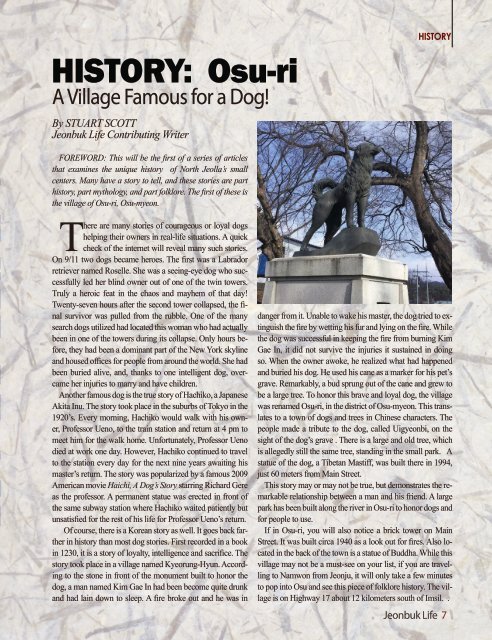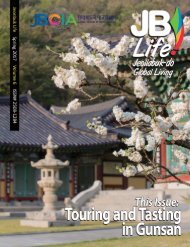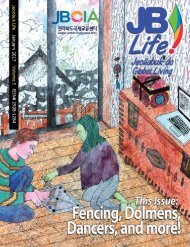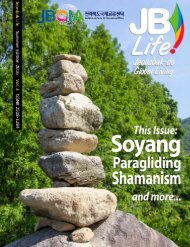JB Life! Volume 2 (Spring 2016)
This is the second quarterly issue of JB Life, a publication meant to showcase the international residents and traditional elements of Jeonbuk Province in South Korea. The magazine is a project of the Jeollabuk-do Center for International Affairs and publishes in January, April, July, and October.
This is the second quarterly issue of JB Life, a publication meant to showcase the international residents and traditional elements of Jeonbuk Province in South Korea. The magazine is a project of the Jeollabuk-do Center for International Affairs and publishes in January, April, July, and October.
Create successful ePaper yourself
Turn your PDF publications into a flip-book with our unique Google optimized e-Paper software.
HISTORY<br />
HISTORY: Osu-ri<br />
A Village Famous for a Dog!<br />
By STUART SCOTT<br />
Jeonbuk <strong>Life</strong> Contributing Writer<br />
FOREWORD: This will be the first of a series of articles<br />
that examines the unique history of North Jeolla’s small<br />
centers. Many have a story to tell, and these stories are part<br />
history, part mythology, and part folklore. The first of these is<br />
the village of Osu-ri, Osu-myeon.<br />
There are many stories of courageous or loyal dogs<br />
helping their owners in real-life situations. A quick<br />
check of the internet will reveal many such stories.<br />
On 9/11 two dogs became heroes. The first was a Labrador<br />
retriever named Roselle. She was a seeing-eye dog who successfully<br />
led her blind owner out of one of the twin towers.<br />
Truly a heroic feat in the chaos and mayhem of that day!<br />
Twenty-seven hours after the second tower collapsed, the final<br />
survivor was pulled from the rubble. One of the many<br />
search dogs utilized had located this woman who had actually<br />
been in one of the towers during its collapse. Only hours before,<br />
they had been a dominant part of the New York skyline<br />
and housed offices for people from around the world. She had<br />
been buried alive, and, thanks to one intelligent dog, overcame<br />
her injuries to marry and have children.<br />
Another famous dog is the true story of Hachiko, a Japanese<br />
Akita Inu. The story took place in the suburbs of Tokyo in the<br />
1920’s. Every morning, Hachiko would walk with his owner,<br />
Professor Ueno, to the train station and return at 4 pm to<br />
meet him for the walk home. Unfortunately, Professor Ueno<br />
died at work one day. However, Hachiko continued to travel<br />
to the station every day for the next nine years awaiting his<br />
master’s return. The story was popularized by a famous 2009<br />
American movie Haichi, A Dog’s Story starring Richard Gere<br />
as the professor. A permanent statue was erected in front of<br />
the same subway station where Hachiko waited patiently but<br />
unsatisfied for the rest of his life for Professor Ueno’s return.<br />
Of course, there is a Korean story as well. It goes back farther<br />
in history than most dog stories. First recorded in a book<br />
in 1230, it is a story of loyalty, intelligence and sacrifice. The<br />
story took place in a village named Kyeorung-Hyun. According<br />
to the stone in front of the monument built to honor the<br />
dog, a man named Kim Gae In had been become quite drunk<br />
and had lain down to sleep. A fire broke out and he was in<br />
danger from it. Unable to wake his master, the dog tried to extinguish<br />
the fire by wetting his fur and lying on the fire. While<br />
the dog was successful in keeping the fire from burning Kim<br />
Gae In, it did not survive the injuries it sustained in doing<br />
so. When the owner awoke, he realized what had happened<br />
and buried his dog. He used his cane as a marker for his pet’s<br />
grave. Remarkably, a bud sprung out of the cane and grew to<br />
be a large tree. To honor this brave and loyal dog, the village<br />
was renamed Osu-ri, in the district of Osu-myeon. This translates<br />
to a town of dogs and trees in Chinese characters. The<br />
people made a tribute to the dog, called Uigyeonbi, on the<br />
sight of the dog’s grave . There is a large and old tree, which<br />
is allegedly still the same tree, standing in the small park. A<br />
statue of the dog, a Tibetan Mastiff, was built there in 1994,<br />
just 60 meters from Main Street.<br />
This story may or may not be true, but demonstrates the remarkable<br />
relationship between a man and his friend. A large<br />
park has been built along the river in Osu-ri to honor dogs and<br />
for people to use.<br />
If in Osu-ri, you will also notice a brick tower on Main<br />
Street. It was built circa 1940 as a look out for fires. Also located<br />
in the back of the town is a statue of Buddha. While this<br />
village may not be a must-see on your list, if you are travelling<br />
to Namwon from Jeonju, it will only take a few minutes<br />
to pop into Osu and see this piece of folklore history. The village<br />
is on Highway 17 about 12 kilometers south of Imsil. .<br />
Jeonbuk <strong>Life</strong> 7







